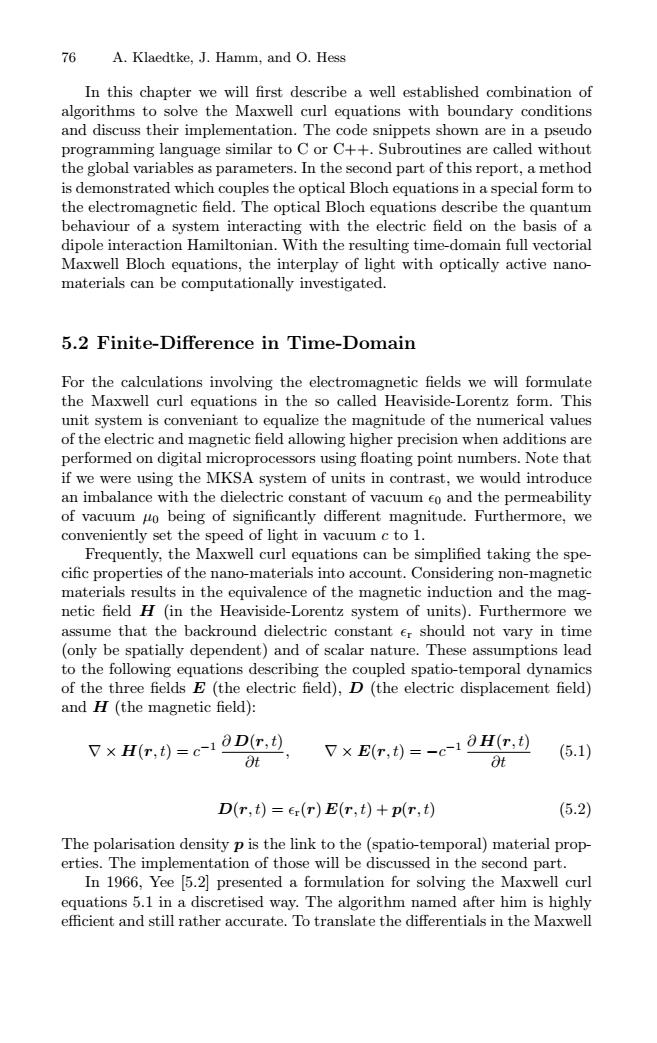正在加载图片...

76 A.Klaedtke,J.Hamm,and O.Hess In this chapter we will first describe a well established combination of algorithms to solve the Maxwell curl equations with boundary conditions and discuss their implementation.The code snippets shown are in a pseudo programming language similar to C or C++.Subroutines are called without the global variables as parameters.In the second part of this report,a method is demonstrated which couples the optical Bloch equations in a special form to the electromagnetic field.The optical Bloch equations describe the quantum behaviour of a system interacting with the electric field on the basis of a dipole interaction Hamiltonian.With the resulting time-domain full vectorial Maxwell Bloch equations,the interplay of light with optically active nano- materials can be computationally investigated. 5.2 Finite-Difference in Time-Domain For the calculations involving the electromagnetic fields we will formulate the Maxwell curl equations in the so called Heaviside-Lorentz form.This unit system is conveniant to equalize the magnitude of the numerical values of the electric and magnetic field allowing higher precision when additions are performed on digital microprocessors using floating point numbers.Note that if we were using the MKSA system of units in contrast,we would introduce an imbalance with the dielectric constant of vacuum co and the permeability of vacuum uo being of significantly different magnitude.Furthermore,we conveniently set the speed of light in vacuum c to 1. Frequently,the Maxwell curl equations can be simplified taking the spe- cific properties of the nano-materials into account.Considering non-magnetic materials results in the equivalence of the magnetic induction and the mag- netic field H (in the Heaviside-Lorentz system of units).Furthermore we assume that the backround dielectric constant er should not vary in time (only be spatially dependent)and of scalar nature.These assumptions lead to the following equations describing the coupled spatio-temporal dynamics of the three fields E (the electric field),D(the electric displacement field) and H (the magnetic field): 7×H(r,)=c-10Dr, (5.1) Ot V×E(r,t)=-c-10H(m,) Ot D(r,t)=er(r)E(r,t)+p(r,t) (5.2) The polarisation density p is the link to the(spatio-temporal)material prop- erties.The implementation of those will be discussed in the second part. In 1966,Yee 5.2 presented a formulation for solving the Maxwell curl equations 5.1 in a discretised way.The algorithm named after him is highly efficient and still rather accurate.To translate the differentials in the Maxwell76 A. Klaedtke, J. Hamm, and O. Hess In this chapter we will first describe a well established combination of algorithms to solve the Maxwell curl equations with boundary conditions and discuss their implementation. The code snippets shown are in a pseudo programming language similar to C or C++. Subroutines are called without the global variables as parameters. In the second part of this report, a method is demonstrated which couples the optical Bloch equations in a special form to the electromagnetic field. The optical Bloch equations describe the quantum behaviour of a system interacting with the electric field on the basis of a dipole interaction Hamiltonian. With the resulting time-domain full vectorial Maxwell Bloch equations, the interplay of light with optically active nanomaterials can be computationally investigated. 5.2 Finite-Difference in Time-Domain For the calculations involving the electromagnetic fields we will formulate the Maxwell curl equations in the so called Heaviside-Lorentz form. This unit system is conveniant to equalize the magnitude of the numerical values of the electric and magnetic field allowing higher precision when additions are performed on digital microprocessors using floating point numbers. Note that if we were using the MKSA system of units in contrast, we would introduce an imbalance with the dielectric constant of vacuum 0 and the permeability of vacuum µ0 being of significantly different magnitude. Furthermore, we conveniently set the speed of light in vacuum c to 1. Frequently, the Maxwell curl equations can be simplified taking the specific properties of the nano-materials into account. Considering non-magnetic materials results in the equivalence of the magnetic induction and the magnetic field H (in the Heaviside-Lorentz system of units). Furthermore we assume that the backround dielectric constant r should not vary in time (only be spatially dependent) and of scalar nature. These assumptions lead to the following equations describing the coupled spatio-temporal dynamics of the three fields E (the electric field), D (the electric displacement field) and H (the magnetic field): ∇ × H(r, t) = c−1 ∂ D(r, t) ∂t , ∇ × E(r, t) = −c−1 ∂ H(r, t) ∂t (5.1) D(r, t) = r(r) E(r, t) + p(r, t) (5.2) The polarisation density p is the link to the (spatio-temporal) material properties. The implementation of those will be discussed in the second part. In 1966, Yee [5.2] presented a formulation for solving the Maxwell curl equations 5.1 in a discretised way. The algorithm named after him is highly efficient and still rather accurate. To translate the differentials in the Maxwell